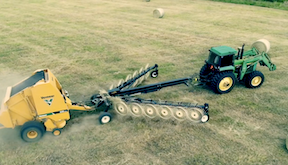
“Our invention was born out of necessity about a decade ago after listening to local farmers talk about wanting a dependable way to increase production, save time and not lose hay behind terraces,” says Joe Waldorff, Elba, Ala. “Their input led us to design and build a flexible rake that could work on flat or hilly fields with multiple terraces.”
Waldorff says he and a few others formed an LLC, started welding and bolting components together, and the rest is history. Now the Flex Rake is used by customers in several U.S. states and Canada. “Over the years we’ve improved the rake as needed so it’s by far the strongest implement on the market, with great features and options incorporated into a superior design,” says Waldorff. “The dominant feature of a Flex Rake is that a producer can combine raking and baling square or round bales into one operation, behind one tractor. That means tremendous savings in time, labor and fuel.”
Flex Rake has a rugged central box beam that houses hydraulic hoses, the baler wiring harness, and a pto drive shaft supported by three bearings. The rake arms, carrying individual wheels with individual suspension, pivot up and down from the main frame. Waldorff says that flexibility allows the rake wheels to follow the land contour, gathering hay without waste. When a Flex Rake is fully closed for road transport, the dolly wheels at the end of the rake arms ramp up so tines have ample clearance above the roadway.
The company produces 8, 10 and 12-wheel models, but Waldorff says the 12-wheel rake is the most popular. “Our 12-wheel model can start gathering an 8-ft. wide swath, and as it hydraulically opens, it can be stopped at any width up to 28 ft., right from the tractor seat at any speed.”
Every rake is made to order with high capacity or standard tines to accommodate different crops. Hydraulic hoses and a wiring harness that match the customer’s baler are also custom-made.
The windrow width on a Flex Rake can be changed by adjusting either wheel row independently. The windrow can also be offset to either side to accommodate baler off-tracking when baling pivot irrigation circles.
Hay deflectors installed in front of the rake spinners keep hay flowing smoothly toward the baler, keep the rakes clean and prevent wrapping. Waldorff says “another advantage is that the spinner wheels are set closer together and at a lesser angle than conventional rakes. This allows for more efficient and cleaner raking as well as extending the operational life of the spinners.”
Flex Rake sells direct to customers without any middlemen because Waldorff says, “We don’t want people to chase a dog’s tail for three days to get an answer. We deliver the implement ourselves and make sure the operator knows how to run it. Our customers are saving up to a third of their production costs and putting their hay up faster.”
Waldorff says the company has streamlined its production over the years and made repair issues simple to handle. “We get very few repair calls, and when we do, we handle them right away because we know that dry hay can’t wait.”
Flex Rake’s pricing ranges from $25,000 and up depending on the size and options a buyer chooses. Rake delivery has been within six weeks, but Waldorff says recent supply chain issues may extend that.
Contact: FARM SHOW Followup, Flex Rake, Elba, Ala. (ph 334-488-0112 or 334-790-3582; flexrake@yahoo.com; www.flexrakellc.com).
